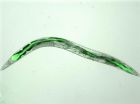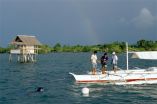(Press-News.org) DOWNERS GROVE, Ill. – October 23, 2014 – An international multicenter study reports that over-the-scope clip (OTSC) placement is a safe and effective therapy for the closure of gastrointestinal (GI) defects, which includes anastomotic leaks, fistulae and perforations. Clinical success was best achieved in patients undergoing closure of perforations or leaks when OTSC placement was used for primary or rescue therapy. The overall clinical success for the closure of perforations and leaks ranged between 90 percent and 73 percent; however, successful closure of fistulae was achieved in less than half of the patients. The type of defect (i.e. perforation or leak) is the best predictor of successful long-term closure. The study appears in the October issue of GIE: Gastrointestinal Endoscopy, the monthly peer-reviewed scientific journal of the American Society for Gastrointestinal Endoscopy (ASGE).
Conventional treatment of GI defects is with surgical management, which is associated with significant morbidity and mortality. Technological advances in endoscopic devices have allowed for endoscopic closure of GI defects. Endoscopic therapies include placement of self-expandable metal stents (SEMSs) and application of clips and sealants, all of which have proven their utility in different clinical scenarios with varying degrees of success. The most common endoscopic approach for treatment of GI defects before the over-the-scope clip was the use of temporary SEMSs.
A large case series reported a success rate as high as 75 percent with SEMSs; however, this practice was associated with a high rate of adverse events (46 percent). The OTSC provides more durable closure than standard clips because of its wider mouth and ability to grasp larger amounts of tissue. In addition, full-thickness closure is achievable because of greater compressive force. The current study is the largest to-date to assess outcomes of OTSCs in the management of GI fistulae, perforations and leaks.
"The primary goal of this study was to describe a large, international, multicenter experience with OTSCs for the management of GI perforations, fistulae and anastomotic leaks and to determine the overall success of GI defect closure. Secondary goals were to determine success rate by type of defect and type of therapy, primary vs. rescue, and to determine predictors of OTSC success," said study lead author Yamile Haito-Chavez, MD, Johns Hopkins University, Baltimore, Maryland. "Our study found that long-term success was achieved in 60.2 percent of patients. The rate of successful closure of perforations was 90 percent, closure of leaks was 73.3 percent and closure of fistulae was 42.9 percent. Long-term success was significantly higher when OTSCs were applied as a primary therapy."
A retrospective review of consecutive patients who underwent attempted OTSC placement (either as primary or rescue therapy) for the indication of GI leak, fistula or perforation at 16 academic centers in the United States, The Netherlands, Germany, Italy, and Chile was conducted between May 2006 and November 2012. Patients were identified by using endoscopic databases at each institution. Anastomotic leak was defined as disruption at a surgical anastomosis resulting in a fluid collection with or without evidence of extravasation of contrast medium on radiologic evaluation. Fistula was defined as abnormal communication between two epithelialized surfaces. Perforation was defined as an unintentional, acute iatrogenic, full-thickness defect in the GI tract. The main outcome measurement was the long-term success of the procedure.
A total of 188 patients (108 fistulae, 48 perforations, 32 leaks) were included. Long-term success was
achieved in 60.2 percent of patients during a median follow-up of 146 days. The rate of successful closure of perforations (90 percent) and leaks (73.3 percent) was significantly higher than that of fistulae (42.9 percent). Long-term success was significantly higher when OTSCs were applied as primary therapy (primary 69.1 percent vs. rescue 46.9 percent). On multivariate analysis, patients who had OTSC placement for perforations and leaks had significantly higher long-term success compared with those who had fistulae.
In an accompanying editorial, Danny Cheriyan, MB, Bch, MRCPI and Robert Enns, MD, FRCP, Division of Gastroenterology, St. Paul's Hospital, University of British Columbia, Vancouver, Canada, state "The future of the OTSC in mainstream endoscopy is promising. It is arguable that these clips should be available in every well-stocked unit, and because application and deployment are similar to those of a standard ligation bander, it would be appropriate for implementation into training and clinical practice in gastroenterology."
INFORMATION:
About the American Society for Gastrointestinal Endoscopy
Since its founding in 1941, the American Society for Gastrointestinal Endoscopy (ASGE) has been dedicated to advancing patient care and digestive health by promoting excellence and innovation in gastrointestinal endoscopy. ASGE, with more than 13,000 members worldwide, promotes the highest standards for endoscopic training and practice, fosters endoscopic research, recognizes distinguished contributions to endoscopy, and is the foremost resource for endoscopic education. Visit http://www.asge.org and http://www.screen4coloncancer.org for more information and to find a qualified doctor in your area.
About Endoscopy
Endoscopy is performed by specially-trained physicians called endoscopists using the most current technology to diagnose and treat diseases of the gastrointestinal tract. Using flexible, thin tubes called endoscopes, endoscopists are able to access the human digestive tract without incisions via natural orifices. Endoscopes are designed with high-intensity lighting and fitted with precision devices that allow viewing and treatment of the gastrointestinal system.
An ocean's oxygen levels may play a role in the impact of marine predators on bodies when they are immersed in the sea, according to Simon Fraser University researchers in a new study published this week in the journal PLoS One.
SFU criminologist Gail Anderson led the study, based on the deployment of a trio of pig carcasses into Saanich Inlet at a depth of 100 metres and studied over the past three years. Anderson assessed scavenger activity while co-author and SFU criminologist Lynne Bell continues her investigation of what happens to submerged bones.
The work is ...
Subjective screening questions do not reliably identify teenagers who are at risk for hearing loss, according to researchers at Penn State College of Medicine. The results suggest that objective hearing tests should be refined for this age group to replace screening questions.
The American Academy of Pediatrics, in partnership with the Bright Futures children's health organization, sets standards for pediatric preventive care. The AAP recommends screening adolescents with subjective questions and then following up with objective hearing tests for those found to be at ...
Just like those of humans, insect guts are full of microbes, and the microbiota can influence the insect's ability to transmit diseases. A study published on October 23rd in PLOS Pathogens reports that a bacterium isolated from the gut of an Aedes mosquito can reduce infection of mosquitoes by malaria parasites and dengue virus. The bacterium can also directly inhibit these pathogens in the test tube, and shorten the life span of the mosquitoes that transmit both diseases.
George Dimopoulos and colleagues from Johns Hopkins University, USA, had previously isolated Csp_P, ...
Orono, Maine — In the southern Peruvian Andes, an archaeological team led by researchers at the University of Maine has documented the highest altitude ice age human occupation anywhere in the world — nearly 4,500 meters above sea level (masl).
Their discoveries date high-altitude human habitation nearly a millennium earlier than previously documented.
Despite cold temperatures, high solar radiation and low oxygen conditions at that altitude, hunter-gatherers colonized the remote, treeless landscapes about 12,000 years ago during the terminal Pleistocene ...
LA JOLLA, CA – October 23, 2014 - Breaking carbon-hydrogen (C-H) bonds to alter existing molecules to create new ones is an increasingly important avenue for drug development. Of particular interest is mirror-image or "one-handed" compounds, but C-H breaking methods for making pure batches of these molecules have worked with only a limited range of starting materials.
Now a team from The Scripps Research Institute (TSRI) has established a new C-H activation technique that opens the door to creating a broader range of pure molecules of one-handedness or "chirality" ...
DURHAM, N.C. -- When pathogenic bacteria like Salmonella or Staphylococcus invade a host, the host organism should respond by going into a state of high alert, altering its metabolism to defend against the attack.
But if the host doesn't reverse course once the battle is won, its efforts will be wasted on defense rather than on repairing the damage done by bacterial invaders.
Duke University researchers have uncovered the genes that are normally activated during recovery from bacterial infection. The finding could lead to ways to jumpstart this recovery process and ...
Over the last decade, powerful new microscopes have dramatically sharpened biologists' focus on the molecules that animate and propel life. Now, a new imaging platform developed by Eric Betzig and colleagues at the Howard Hughes Medical Institute's Janelia Research Campus offers another leap forward for light microscopy. The new technology collects high-resolution images rapidly and minimizes damage to cells, meaning it can image the three-dimensional activity of molecules, cells, and embryos in fine detail over longer periods than was previously possible.
The developers ...
To protect our oceans from irreversible harm, governments, conservationists, and researchers around the world must address the enormous threat posed by unregulated and destructive fisheries, say top marine scientists.
In an article published today in Science, Prof. Amanda Vincent of Project Seahorse at the University of British Columbia and Dr. Jean M. Harris of Ezemvelo KZN Wildlife in South Africa call for bold new approaches to the pressing global issue of overfishing and habitat destruction, including networks of marine protected areas, co-ordinated governance, and ...
This news release is available in German. Viral infections always follow a similar course. The pathogen infiltrates the host cells and uses their replication and protein production machinery to multiply. The virus has to overcome the initial barrier by docking on the surface of the cell membrane. The cell engulfs the virus in a bubble and transports it towards the cell nucleus. During this journey, the solution inside the bubble becomes increasingly acidic. The acidic pH value is ultimately what causes the virus's outer shell to melt into the membrane of the bubble.
Capsid ...
A DNA mutation that can lead to horses being genetically male, but female in appearance, may explain at least two cases of controversial sexual identity, according to research led by professors from the Texas A&M College of Veterinary Medicine & Biomedical Sciences (CVM) and published in PLOS Genetics.
This type of genetic abnormality is caused by a mutation called DNA copy number variation (CNV), in which there are deletions and duplications in the genome typically larger than 50 base pairs.
These variations are one way that individuals of the same species are genetically ...


